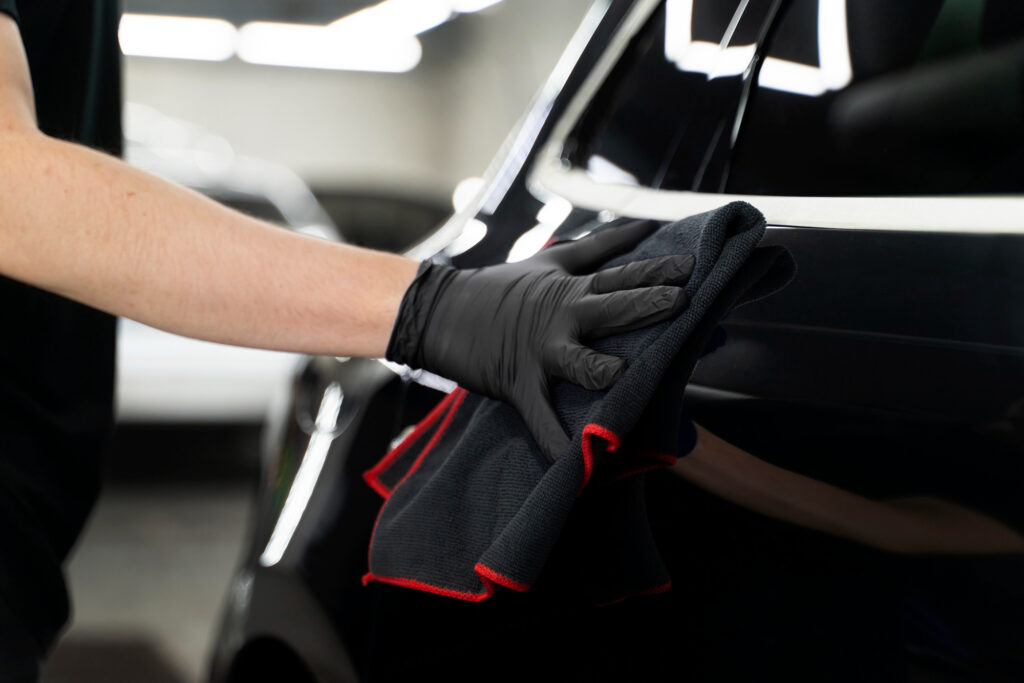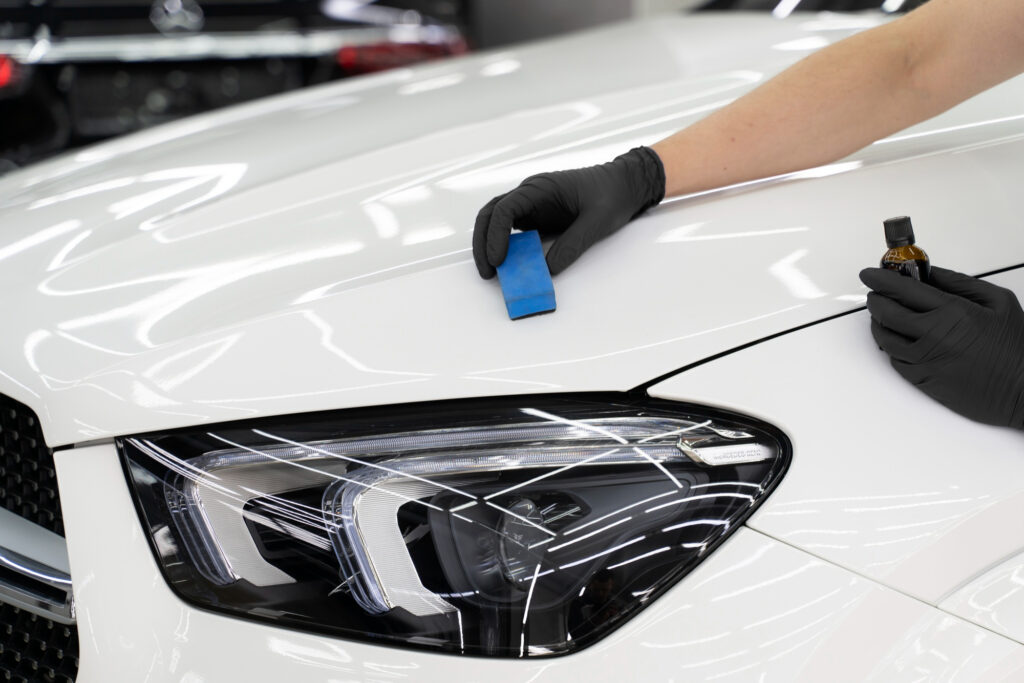Introduction to Vehicle Protection in Denver
Living in Denver, where intense sunlight, snow, hail, and road salt are part of daily life, protecting your car’s exterior is essential to maintain its appearance and value. The city’s high altitude amplifies UV exposure, while winter conditions and unpredictable hailstorms pose constant threats to your vehicle’s paint. For Denver car owners, choosing the right protection method is critical. Two popular options dominate the conversation: ceramic coating and traditional car wax. But which provides superior long- term protection for Denver’s unique climate?
This guide provides a comparison of ceramic coating and wax, detailing their benefits, limitations, and suitability for Denver’s environment. We address questions concerning durability, cost, and maintenance, to support an informed choice. Whether navigating icy roads or parking under Colorado sun, understanding these options will help keep your car in optimal condition.
Ceramic coatings utilize cutting-edge technology for formidable protection, while wax delivers a classic, cost-effective gloss. Both serve a purpose, but Denver’s climate warrants close evaluation. Let’s examine the specifics to identify the top choice for lasting vehicle defense.
Understanding Ceramic Coating
Ceramic coating is a liquid polymer that chemically bonds with a vehicle’s factory paint, creating a durable, protective layer. Using nanotechnology, typically with silicon dioxide (SiO2), it forms a hydrophobic surface that repels water, dirt, and contaminants. This makes it highly effective against Denver’s environmental challenges, such as intense UV rays, road salt, and chemical contaminants like bird droppings or tree sap.
The application process is meticulous, requiring a clean surface free of imperfections. Professionals wash, clay, and polish the vehicle before applying multiple layers of coating, which cure over 24-48 hours to form a hard, glass-like finish. This process ensures optimal adhesion and longevity, often lasting two to five years with proper care. For Denver drivers, this durability is a significant advantage, reducing the need for frequent maintenance in a city where weather can be relentless.
Exploring Traditional Car Wax
Car wax, derived from natural carnauba or synthetic blends, is a time-tested solution for protecting vehicle paint. Applied as a paste or liquid, it creates a sacrificial layer that enhances shine and fills minor surface imperfections. Waxing is straightforward: after washing and drying the car, you apply the wax, let it haze, and buff it to a glossy finish. This simplicity makes it popular among DIY enthusiasts.
In Denver, wax provides basic protection against UV rays and light debris, giving your car a polished look. However, its effectiveness wanes quickly under harsh conditions like intense sunlight or winter snow, requiring reapplication every one to three months. While affordable, wax demands more frequent effort to maintain protection, which may not suit every Denver driver’s lifestyle.
Durability: A Key Differentiator
The main difference between ceramic coating and wax is durability. Ceramic coating forms a molecular bond with paint, creating a resilient barrier against UV rays, heat, and environmental wear—lasting years without reapplication. This offers peace of mind during Denver’s hail season and unpredictable weather.
Wax sits atop the paint and wears away with washing, weather, or driving. Denver’s sun, grit, and snowstorms degrade wax quickly, often requiring frequent touch-ups. Ceramic’s durability stands out for lasting protection in these conditions.
Protection Capabilities Compared
Ceramic coating excels at shielding against diverse threats. Its hard, glass-like surface resists scratches, chemical etching, and oxidation, while its hydrophobic nature causes water, mud, and ice to bead and run off. This is especially valuable in Denver, where deicing salt corrodes paint and intense sunlight accelerates fading.
Wax provides moderate shine and protection from minor contaminants, but cannot prevent damage from hail or harsh sun exposure. Ceramic’s tougher surface better resists Denver’s environmental hazards.
Application Process and Practicality
Applying ceramic coating is a detailed process that requires professional preparation, including washing, claying, and polishing. Once applied, it cures into a durable layer, offering long-lasting protection ideal for Denver conditions.
Waxing is simpler, needing only a clean car and basic supplies. It can be done at home in a few hours, making it accessible for hobbyists. However, improper use in Denver’s punishing sun may cause streaking, reducing its effectiveness. While more accessible, properly-applied ceramic saves time over years.
Cost Considerations: Upfront vs. Long-Term
Wax is affordable and sufficient for multiple applications. However, frequent reapplication means ongoing time and labor.
Ceramic coating is a higher upfront investment depending on car and product, but its multi-year durability can be cost-effective over time, particularly in Denver’s harsh conditions. Ceramic-coated vehicles may also retain higher resale values.
Maintenance Needs
Maintaining a ceramic-coated car is straightforward. Its hydrophobic surface repels dirt, making washing easier with pH-neutral soaps. Periodic inspections ensure the coating remains intact, reducing upkeep time for busy Denverites.
Wax demands more frequent maintenance. After each wash, you may need to reapply, and Denver’s dust, pollen, and snow can dull the finish quickly. Regular buffing is necessary to maintain protection, which can be labor-intensive. Ceramic’s low- maintenance appeal makes it ideal for those seeking convenience.
Denver’s Climate: Why It Matters
Denver’s climate—over 300 sunny days, high-altitude UV, and harsh winters—requires robust protection. Ceramic’s UV resistance and hydrophobic surface excel in these conditions, while wax struggles to keep up long-term.
For more insights on protecting your car from Colorado’s elements, check out our article on Paint Protection Film in Centennial.

Advantages and Disadvantages of Ceramic Coating
Ceramic coating offers significant benefits for Denver cars:
- Longevity of two to five years.
- Superior resistance to scratches, UV rays, and chemicals.
- Easy cleaning due to hydrophobic properties.
- Enhanced gloss and color vibrancy.
Drawbacks include higher initial costs and the need for skilled application. Removal, if necessary, is also more involved. In Denver’s climate, however, the advantages usually outweigh these drawbacks for lasting protection.
Advantages and Disadvantages of Wax
Wax’s strengths include:
- Affordable and easy to apply at home.
- Immediate, warm shine.
- Flexibility to change or remove without commitment.
Still, its brief lifespan and minimal defense against serious damage are notable drawbacks. In Denver, repeated reapplication quickly becomes a chore.
Choosing the Right Option for Your Denver Car
The choice between ceramic coating and wax depends on your priorities. Ceramic coating is best for those needing durable, low-maintenance protection against Denver’s severe weather, especially for daily drivers or vehicles facing hail and strong UV rays. Wax suits budget-focused owners or those who enjoy frequent car care.
Consider your driving habits: frequent mountain trips call for ceramic’s resilience, while occasional city driving might be adequately served by wax. For tailored solutions, professional services like those at Auto Image 360, with over 20 years of experience, can guide you.
Discover our Ceramic Pro Coating services to learn how we can protect your vehicle.
Real-World Scenarios
Imagine a Denver commuter with a ceramic-coated sedan; snow and ice slide off, and winter salt causes no damage. Meanwhile, a waxed SUV needs monthly reapplication and shows UV wear by summer. Ceramic-coated cars maintain higher value and last through multiple seasons, demonstrating their edge in Denver.
Answering Common Questions
Many Denver drivers ask: Can ceramic coating prevent hail damage? It offers some protection against minor impacts but isn’t a substitute for professional hail repair. Another question: Is waxing over ceramic necessary? No, as ceramic provides superior shine and protection. For wax users, reapplication every one to two months is recommended in Denver due to intense weather.
Conclusion: Protecting Your Investment
For Denver cars, ceramic coating outshines wax for long-term protection, offering unmatched durability, comprehensive defense, and low maintenance. While wax is affordable and easy, its frequent reapplication makes it less practical in Denver’s challenging climate. Investing in ceramic coating ensures your vehicle withstands UV rays, hail, and winter elements, preserving its value and appearance.
Ready to safeguard your car? Auto Image 360, serving Denver, Greenwood Village, Parker, and Centennial, specializes in premium Ceramic Pro coatings. Request a free quote today or contact us for a consultation. Protect your car for the long haul with our expert service


